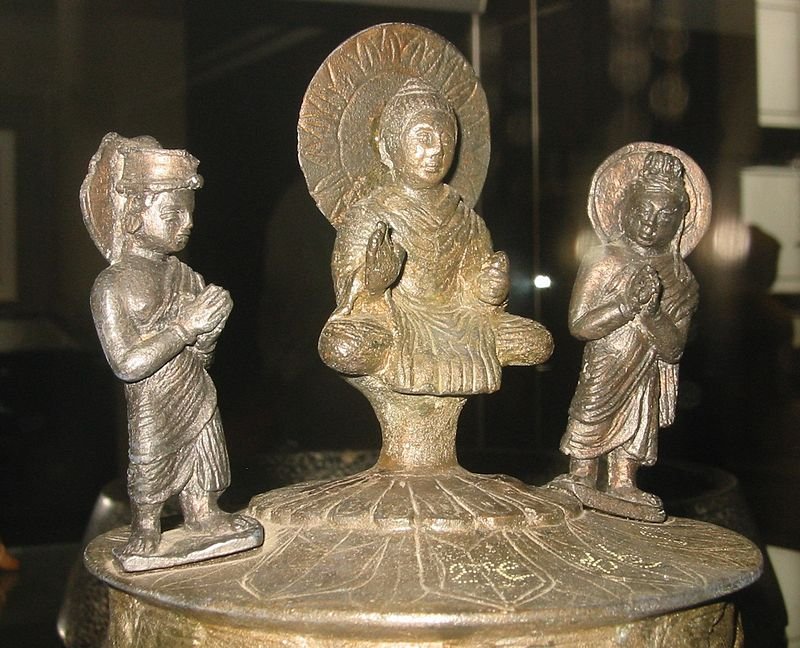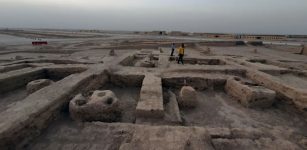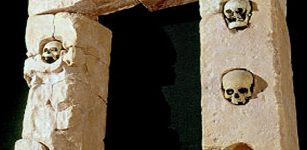Kanishka Casket – Beautiful Ancient Buddhist Treasure In Gilded Copper
A. Sutherland - AncientPages.com - The Kanishka Casket (known as the Kanishka reliquary) is a beautiful Buddhist treasure of gilded copper. The relic dates back to the first year of the reign of the Kushan emperor Kanishka, in 127 AD.
Kanishka casket, Asia, G33 South Asia British Museum, England. Image credit: Anthony Huan - CC BY-SA 2.0
It was discovered in a deposit chamber under the massive Kanishka stupa during British archaeological excavations in 1908 - 1909 in Shah-ji-Dheri on the peripheries of Peshawar, Pakistan. Chinese Buddhist pilgrims described this gigantic structure in the 7th century as the tallest stupa in India. It was indeed an enormous structure.
The stupa is believed to have influenced later constructions of stupas throughout ancient Turkistan. These wooden towers, topped with metal chatras (chhatra (meaning "umbrella"), made such buildings act as lightning rods.
It was probably considered dangerous, so this structure gradually disappeared.
Undoubtedly, the Kanishka stupa is a valuable historical and cultural landmark, but so is the Kanishka Casket, which was unearthed with three small bone fragments of Buddha. The bones were transported to Burma by the British following the excavation, where they are still stored.
In Peshawar, Pakistan, the Kanishka stupa has been described as one of the tallest in the world and has been visited by early Chinese Buddhist pilgrims. One of them was Faxian (337 AD – c. 422 AD), a Chinese Buddhist monk and translator who traveled by foot from China to India, visiting sacred Buddhist sites.
The Kanishka Casket, is the precious the artifact (just over 19 cm in height, with a diameter of 10 cm or more) is now in the Peshawar Museum, and the British Museum has its copy.
Detail of the Buddha, surrounded by cherubs, with devotee or bodhisattva. Image source
The casket is dedicated to the Kharoshthi script, an ancient Indian script used in Gandhara (now Pakistan and north-eastern Afghanistan) to write Gandhari Prakrit and Sanskrit. The script was also used in Central Asia.
The inscription reads:
"In Kanishkapura city, this incense box is the great king Kanishka's monastery's superintendents of construction of the fire hall, Mahasena's and Samgharakshita's, donation.
May it be for the benefit and pleasure of all living beings. In possession of the Sarvastivadin teachers."
Originally it was long believed that the text is signed by a Greek artist named Agesilas, who oversaw work at Kanishka's stupas ('caitya'), confirming the direct involvement of Greeks with Buddhist realizations at such a late date:
"The servant (dasa) Agisalaos, the superintendent of works at the vihara of Kanishka in the monastery of Mahasena" ("dasa agisala nava-karmi ana*kaniskasa vihara mahasenasa sangharame").
However, recent cleaning of the Kanishka Casket revealed that the inscription's old reading was inaccurate. Instead, the name is to be read 'agnisala' (instead of 'Agisalaos') and refers to the monastery, not a person.
 Kanishka Casket - Detail of the Indra, Buddha, Brahman trilogy. Image source
Kanishka Casket - Detail of the Indra, Buddha, Brahman trilogy. Image source
The casket's lid depicts the Buddha on a lotus pedestal and worshipped by Brahma and Indra.
"On the body of the casket, there is a standing figure of a man in Kushana costume and a row of small, active naked figures carrying a garland. In its swags appear other figures, either half-length or composed in the attitude of meditation". 1
The edge of the lid is decorated by a frieze of flying geese, or hamsa, used in Hinduism and Buddhism, as a symbol of protection against the evil eye and the symbol representing the interplay of the body's body chakras, the concept found in the early traditions of Hinduism. The 'hamsa' also means the travel of departing souls and the removal from samsara (the idea of rebirth and "life, matter, existence," all moving in cycles), a fundamental belief of most Indian religions.
The body of the casket represents a Kushan monarch, probably Kanishka in person, with the Iranian Sun god and Moon god at his side. On the sides are two images of a seated Buddha, worshiped by a royal figure, possibly a bodhisattva (one who can reach nirvana but delays doing so through compassion for suffering beings.)
Kanishka (or Kanishka the Great) was an emperor of the Kushan dynasty in the second century (c. 127–150 CE). He is famous and remembered for his military, political, and spiritual achievements. His native language is unknown.
Written by – A. Sutherland - AncientPages.com Senior Staff Writer
Updated on April 11, 2023
Copyright © AncientPages.com All rights reserved. This material may not be published, broadcast, rewritten or redistributed in whole or part without the express written permission of AncientPages.com
Expand for references- Myer, Prudence R. "Again the Kanishka Casket." The Art Bulletin48, no. 3/4 (1966): 396-403
Loeschner Hans, “The Stūpa of the Kushan Emperor Kanishka the Great”
More From Ancient Pages
-
 Reliefs And Engravings Of Celestial Bodies And A Zodiac On Walls And Ceilings Of Luxor’s Esna Temple
Archaeology | Oct 5, 2023
Reliefs And Engravings Of Celestial Bodies And A Zodiac On Walls And Ceilings Of Luxor’s Esna Temple
Archaeology | Oct 5, 2023 -
 Swedenborg: Man Of Unaccountable Talents, Scholar, Great Intellect And His ‘Spiritual Awakening’
Featured Stories | Jun 28, 2018
Swedenborg: Man Of Unaccountable Talents, Scholar, Great Intellect And His ‘Spiritual Awakening’
Featured Stories | Jun 28, 2018 -
 Intriguing Ancient Roman Road Discovered Under The New Town In Devon
Archaeology | Feb 7, 2023
Intriguing Ancient Roman Road Discovered Under The New Town In Devon
Archaeology | Feb 7, 2023 -
 Viking Age Horse Bridle Found Under The Ice 2,000 Meters Above Sea Level
Archaeology | Sep 28, 2023
Viking Age Horse Bridle Found Under The Ice 2,000 Meters Above Sea Level
Archaeology | Sep 28, 2023 -
 Shrine Discovered In Egyptian Temple And Evidence Of Previously Unknown Rituals
Archaeology | Oct 6, 2022
Shrine Discovered In Egyptian Temple And Evidence Of Previously Unknown Rituals
Archaeology | Oct 6, 2022 -
 Never-Before-Seen 3,000-Year-Old Paintings Of Egyptian Goddess Amentet Discovered Inside Coffin Of A Mummy
News | Apr 7, 2020
Never-Before-Seen 3,000-Year-Old Paintings Of Egyptian Goddess Amentet Discovered Inside Coffin Of A Mummy
News | Apr 7, 2020 -
 Inscription On Pokotia Monolith Reveals Sumerians Visited Peru Thousands Of Years Ago
Ancient Symbols | Sep 1, 2015
Inscription On Pokotia Monolith Reveals Sumerians Visited Peru Thousands Of Years Ago
Ancient Symbols | Sep 1, 2015 -
 Pottery Found On Jiigurru/Lizard Island Rewrites Aboriginal History
Archaeology | Apr 12, 2024
Pottery Found On Jiigurru/Lizard Island Rewrites Aboriginal History
Archaeology | Apr 12, 2024 -
 New Genes May Explain Why Humans Got Such Big Brains
Archaeology | Jun 2, 2018
New Genes May Explain Why Humans Got Such Big Brains
Archaeology | Jun 2, 2018 -
 1,600-year-old Roman mosaics from ancient Serdica discovered in Sofia, Bulgaria
Artifacts | Aug 30, 2015
1,600-year-old Roman mosaics from ancient Serdica discovered in Sofia, Bulgaria
Artifacts | Aug 30, 2015 -
 Ancient Parthian City With Hundreds Of Artifacts Unearthed In Iraq
Archaeology | Aug 16, 2022
Ancient Parthian City With Hundreds Of Artifacts Unearthed In Iraq
Archaeology | Aug 16, 2022 -
 Ancient Wooden Spade Found Under Melting Ice In Norway – Archaeologists Urge Hikers To Stay Alert
News | Sep 16, 2024
Ancient Wooden Spade Found Under Melting Ice In Norway – Archaeologists Urge Hikers To Stay Alert
News | Sep 16, 2024 -
 Ancient Mysteries Of Chicago: Is The Puzzling Waubansee Stone A Neglected Pre-Columbian Artifact?
Artifacts | Mar 4, 2017
Ancient Mysteries Of Chicago: Is The Puzzling Waubansee Stone A Neglected Pre-Columbian Artifact?
Artifacts | Mar 4, 2017 -
 Judahite Shrine Of Biblical Arad Reveals Ancient Use Of Cannabis And Frankincense
Archaeology | Jun 2, 2020
Judahite Shrine Of Biblical Arad Reveals Ancient Use Of Cannabis And Frankincense
Archaeology | Jun 2, 2020 -
 Yasuke – The First Black Samurai Caused A Sensation In Japan
Featured Stories | Oct 25, 2019
Yasuke – The First Black Samurai Caused A Sensation In Japan
Featured Stories | Oct 25, 2019 -
 Ancient Burial Site At Vulci Reveals Treasure Of Coins Dated To 3rd Century B.C
Archaeology | Jul 12, 2018
Ancient Burial Site At Vulci Reveals Treasure Of Coins Dated To 3rd Century B.C
Archaeology | Jul 12, 2018 -
 Ancient Cult Of Human Skulls And Communication With The Other World
Ancient Traditions And Customs | Mar 21, 2019
Ancient Cult Of Human Skulls And Communication With The Other World
Ancient Traditions And Customs | Mar 21, 2019 -
 Mabon Festival And The Autumn Equinox Celebrated By Pagans
Ancient Traditions And Customs | Sep 19, 2024
Mabon Festival And The Autumn Equinox Celebrated By Pagans
Ancient Traditions And Customs | Sep 19, 2024 -
 Hun Warrior’s Grave Filled With Gold Treasures Discovered In Romania
Archaeology | Feb 6, 2023
Hun Warrior’s Grave Filled With Gold Treasures Discovered In Romania
Archaeology | Feb 6, 2023 -
 LIDAR Technology Reveals Lost Bronze Age Forts In Devon
Archaeology | May 4, 2020
LIDAR Technology Reveals Lost Bronze Age Forts In Devon
Archaeology | May 4, 2020


